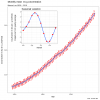Megalomando
Well-Known Member
Good question. Under traditional lighting heat is always a concern. With LED lighting, they run so cool, heat isn't much of a factor. It's easy to get too much light with COBs and that is much more concerning to me, especially with early/mid Veg. I'd like to know what is the most that is good.



